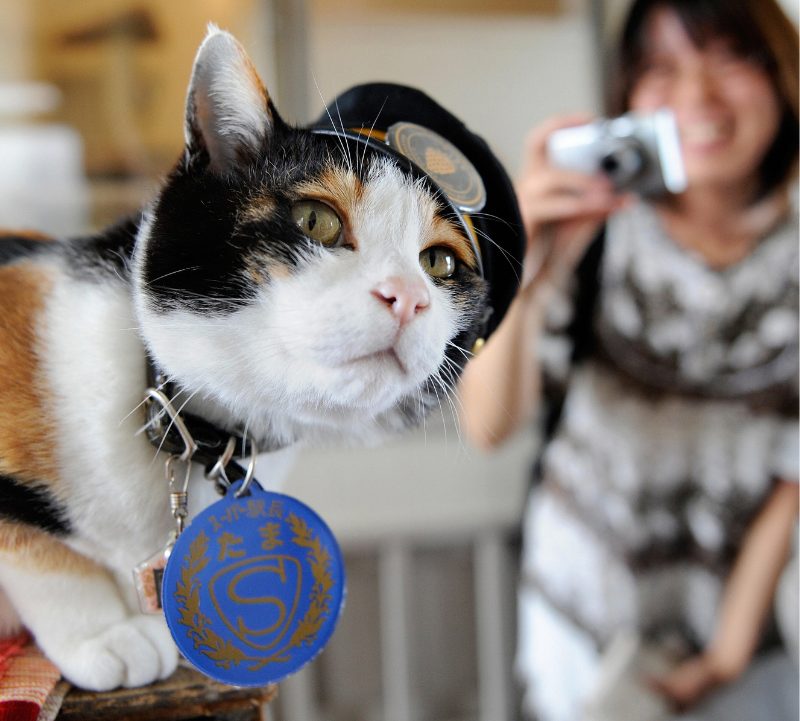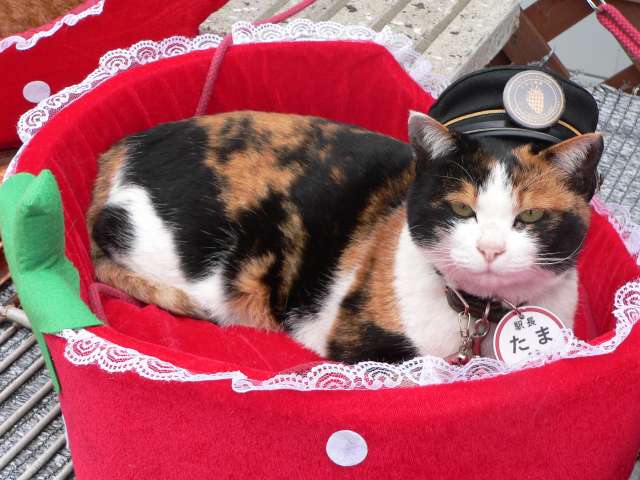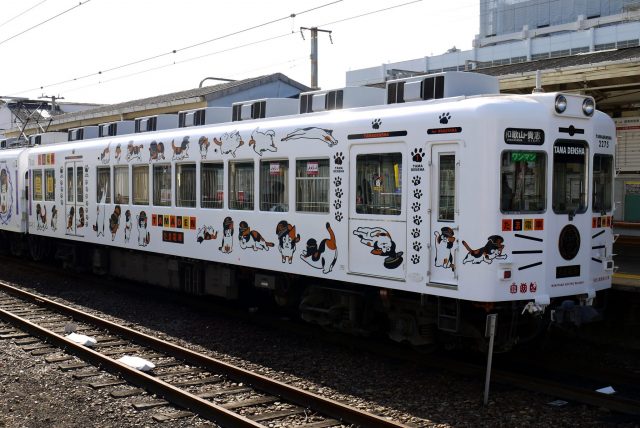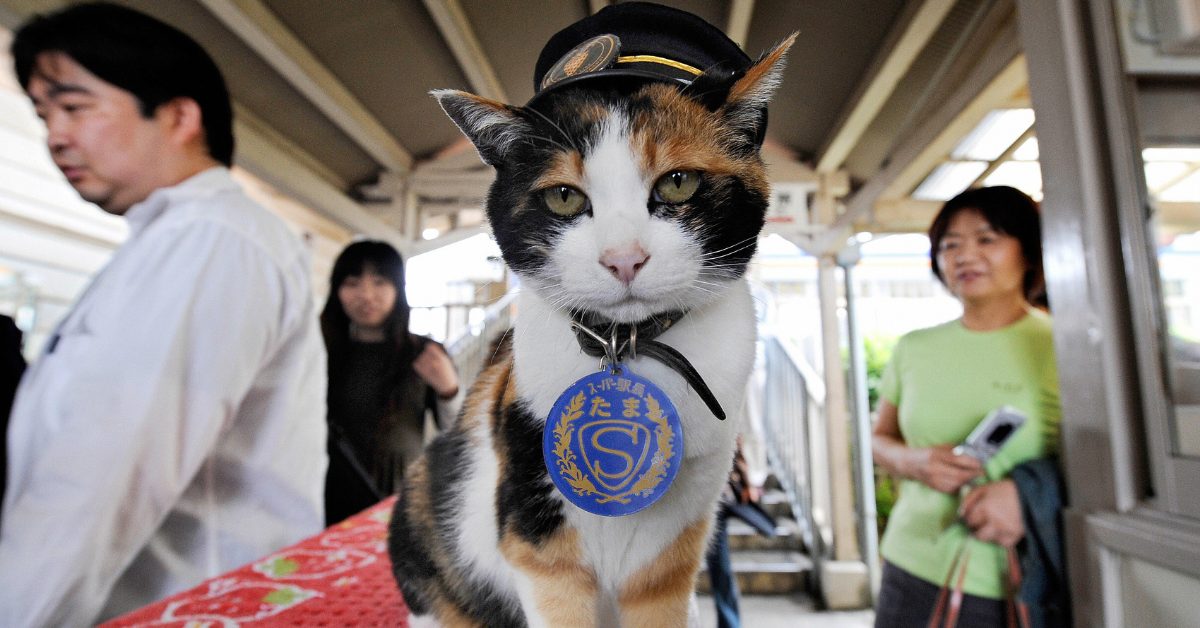Animals have always held a special place in the hearts of humans. But Stationmaster Tama, a cat in Japan, managed to capture the heart of a whole city and contribute 1.1 billion yen to the local economy.
Kishi station was looking for a hero
Kishi Station in Kinokawa, Wakayama Prefecture, Japan, is part of the Wakayama Electric Railway Line. In 2004, the station was facing closure and was only saved by protest from the locals. However, two years later, the railway company decided to de-staff all stations on the Kishigawa Line to save costs.
At that time, the station manager was Toshiko Koyama, a man who had taken to feeding a group of stray cats who lived near the station. A calico cat named Tama was a particular favorite with commuters, being both mild and friendly. She was often found sunbathing at the station, happy to be stroked and petted by passersby.

When it was time for Koyama to move on, he requested that the railway line continue to look after Tama. The president at the time, Mitsunobu Kojima, was so taken with the cat that he not only officially made her stationmaster in 2007, but he also had a little hat made for her. The cat’s salary was a year’s worth of cat food, and she was given a gold nametag with her name and position etched onto it.
As stationmaster, Tama’s role was not only to greet the riders and railway staff, but also to promote the railway. In fact, publicity around her appointment increased the number of passengers visiting Kishi by 17% that month alone. By March 2007, statistics indicated that 10% more people were riding the trains just to see Tama.
Stationmaster Tama quickly gained fans
In March 2008, Tama was promoted to “super stationmaster,” a title that brought with it an “office” — namely, a converted ticket booth with a litter tray and a bed. Tama proved to be so popular that the gift shop started stocking Tama souvenirs, such as badges, keyrings, and candy.

The accolades kept coming, and in October 2008, Tama was knighted. For this, a little blue dress with white lace neck ruffles was made especially for the cat. When bonus season came round, Tama received a special cat toy and a slice of crab meat, fed to her by the company president himself. A special portrait of her was also commissioned to hang in the station.
In 2009, the award-winning industrial designer Eiji Mitooka was hired to design a “Tama train” with cartoon depictions of the famous cat. The front of the train was even given whiskers, and inside the carriages have wooden floors and shelves of children’s books. The doors open to the pre-recorded sound of Tama meowing.

The station building itself also got a makeover by Mitooka in 2010. The new design resembled a cat’s face, incorporating ears on the roof. There are even stylized roof windows poking up from the thatch which imitate a cat’s eyes, especially on an evening when the lights inside make them glow yellow.
In her fourth year as stationmaster in 2011, Tama was promoted to Managing Executive Officer, the third-highest position, just below the company president and the managing director. By then, she already had two assistant stationmasters: her sister Chibi and her mother Miiko. When she’d been in her role for six years, she was elevated to Honorary President of Wakayama Electric Rail.
However, by this time, Tama was 14 years old, and it was decided that rather than being on view in the office from Monday through Saturday, Tama would only be there Tuesday through Friday.
Tama’s successors continue her legacy
When she passed away in 2015, thousands came to lay flowers and tins of cat food at the station. A small shrine was erected on the platform, and she was elevated to the status of a spirit goddess. She was given the posthumous title of Honorary Eternal Stationmaster.
Studies suggest that 55,000 extra passengers were brought to the Kishigawa Line in 2007 thanks to Tama, and that during her time as stationmaster from 2007 to 2015, she increased passenger figures by 300,000, earning around 1.1 billion yen for the economy.
Tama might no longer be with us, but her legacy lives on. In 2017, to celebrate what would have been her 18th birthday, Google produced a Google Doodle in her honor. There is even a Twitter account that continues under her name, which, at the time of writing, has over 83,000 followers.
Once the traditional mourning period was over, Tama’s successor was appointed: Nitama, a name that means “Second Tama.” Nitama had been rescued and trained at Idakiso Station, five stops away from Kishi Station.

The new stationmaster’s first duty was to pay her respects to her predecessor at Tama’s shrine, a ceremony which is repeated every year on June 23.
One candidate considered for Tama’s successor was Sun-tama-tama (a pun on Santama, which translates as “third Tama”). However, Sun-tama-tama had been working at Okayama station, and when it was suggested that she should be moved to Kishi, the PR representative looking after Sun-tama-tama refused to give her up.
More from us: Viking Cats – DNA Study Shows the Crucial Role Felines Played in Viking Life
Always with an eye to the future, Nitama also has a successor being trained up: Yontama (“Fourth Tama”). Introduced to the railway at only eight months old, Nitama is training at Idakiso Station as well.
All of Tama’s successors have been calico cats, just like her, so the image of a cute, tri-colored cat continues to bring passengers flocking to the railway line.
